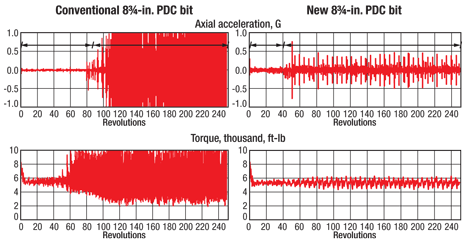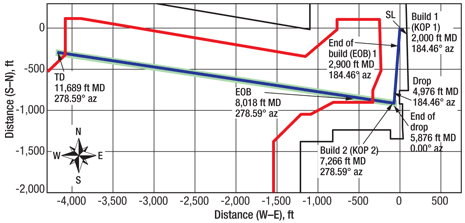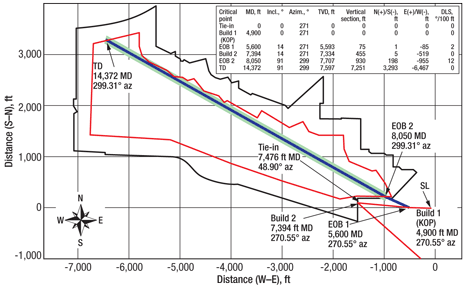The new cutter technology brought the advantages of PDC drilling to applications in abrasive formations that had previously required roller-cone bits.
Ryan Baker, Yuelin Shen and John Zhang, Smith Technologies; and Scott Robertson, Chesapeake
The Barnett Shale play in the Fort Worth Basin has become a substantial source of US natural gas production. Successfully drilling to the producing horizontal section, however, requires an ever-increasing amount of directional control. It is critical to optimize borehole placement and maximize total lateral footage within the producing horizon to enhance project economics. Additionally, in the vertical build-and-hold section, the operator must drill the sharp, abrasive Atoka sandstone and Bend conglomerate, which usually require several bits to complete the entire section. These formations have historically been drilled with roller-cone bits because standard polycrystalline diamond compact (PDC) bits and cutters do not have the required wear and impact resistance to withstand the punishment of the downhole environment without sustaining dramatic rate-of-penetration (ROP) reductions.
In this case, the operator required new cutter technology to efficiently drill the hardest, most abrasive sections of the Pennsylvanian Atoka sandstone and Bend conglomerate (about 80% sandstone). The PDC bit body also needed to provide superior directional control to efficiently deliver the complex borehole geometries. This article describes the methods used in developing the challenging 13-mm cutter for maximum wear resistance through a series of applications in the Atoka and Bend sandstones.
BACKGROUND
The Barnett Shale in north central Texas poses unique surface boundary complexities with regard to efficient well spacing and maximizing natural gas production per acre. For this reason, pad drilling has been designed and developed over the past several years to drill beneath neighborhoods, roads, schools, industrial areas and lakes. From these multi-well locations, directional drilling practices commence, sometimes immediately below the surface in the 12¼-in. hole, and continue with dramatic displacements in the 8¾-in. intervals between drill-out of the surface casing and the kickoff point (KOP) to horizontal.
The stringent directional requirements make BHA component selection critical because it affects performance throughout the entire hole section. A limiting factor is the inability to maintain toolface control of a PDC drill bit once it is damaged and/or wear has developed at the cutting elements (i.e., PDC cutters). Maintaining directional control is integral in these complex wellbore geometries. The Atoka sandstone and Bend conglomerate make it difficult for the directional assemblies and motors to maintain toolface control, even with an undamaged PDC bit. After wear and/or impact damage, the ability to slide the directional assembly in a constant toolface direction becomes increasingly difficult. When this occurs, a roller-cone bit has been tripped in to satisfy directional requirements. The crushing mechanics of a roller cone, as compared with the shearing action of a PDC bit, provide for good and predictable toolface control.
CUTTER DEVELOPMENT
The challenging 8¾-in. hole section contains several abrasive sand intervals starting from below the surface casing (about 1,500 ft), to the KOP (ranging 5,500−8,000 ft MD.) Conventional PDC cutters dulled quickly due to wear, impact and thermal fatigue, thus limiting drilling efficiency. For this reason, the operator required that new cutter technology be developed to enhance PDC bit capabilities. First, the field performance data and cutter failure modes were documented by the local engineering group. Detailed dull analysis and failure mechanism investigation were conducted by R&D engineers. The information was shared with the service provider’s diamond vendors, and development request and targets were set. Materials selection and innovative processes were developed by the engineering team to produce the experimental cutters.
The new cutters are designed and manufactured using an innovative technology that delivered superior properties in both laboratory and field tests. Manufacturing involves a two-step high-pressure/high-temperature (HPHT) process. The first step is to make a polycrystalline diamond (PCD) table using conventional HPHT parameters. The second step is to attach the PCD table on a new tungsten carbide (WC) substrate under extreme HPHT parameters. The advantages of this method compared with a conventional one-step process are that the residual stresses existing in the PCD table and near the PCD/WC interface are optimized and that the microstructure of the two-step process is enhanced due to higher temperature and pressure.
Laboratory tests have indicated that this type of cutter has enhanced abrasion and thermal fatigue resistance compared with conventional PDCs while not compromising impact resistance. Lab testing on hard and abrasive granite suggests that the new cutter has three to four times the wear life of a conventional premium cutter.
In this case, vertical turret lathe (VTL) tests were conducted to compare the wear resistance of the service provider’s premium cutter with that of the newly designed cutter. In the test, the cutter is used to cut a piece of granite under the exact same conditions and parameters. The wear flat size is recorded after cutting a certain volume of rock.
BIT CHASSIS DEVELOPMENT
In the Barnett play, the Atoka sandstone and Bend conglomerate have unconfined compressive strength (UCS) ranging 10,000−18,000 psi. To create a bit that can drill the soft shale sections above and below these sandstone intervals at an acceptable ROP and still maintain a sharp cutting structure through the challenging abrasive and impact-prone sands requires a delicate balance.
To ensure that the bit remains dynamically stable, the service provider utilized a sophisticated 4D modeling system in addition to a full-scale analysis of bit behavior and requirements on the specific BHA. This analysis included hundreds of studies of the bit behavior in both sliding and rotating modes in multiple locations within the well. Engineers also analyzed the bit/BHA dynamics across shale-to-sand and sand-to-shale transitions similar to the actual field conditions, Fig. 1.
 |
|
Fig. 1. The new bit has lower axial bounce compared to the benchmark bit, which translates to more constant torque response and improved footage and ROP while sliding and rotating.
|
|
Using the modeling program in combination with the new cutter technology, engineers designed and manufactured the six-bladed, 8¾-in. bit fitted with backup cutters and optimized blade and nozzle geometry for enhanced cleaning and maximum hydraulic efficiency to aggressively clean and cool the cutters. The new PDC bit is directionally certified to be dynamically stable and capable of efficient toolface control. The backup cutters increase durability by reducing loading in areas prone to abrasive wear. Finally, a longer gauge feature was incorporated to maintain tangent sections with minimal sliding.
CASE STUDIES
The following three case studies will document how the combination of the new cutter technology and the new stable bit body met the challenge of drilling the difficult directional intervals with greater efficiency then previous PDC technology.
Challenges. Generally, PDC bit dulling in the area has caused sliding penetration rates to fall to unacceptable levels. Downhole motor failure is the other predominant reason for a directional drill-out BHA to be pulled out of the hole, which can cause the motor power section to fall apart in small pieces (i.e., chunking). The higher torque and differential pressure required to drill with a PDC bit can lead to this premature motor failure. Downhole motor failure can be mistaken for a dull bit, because differential pressure is difficult to achieve when weight on bit is applied in both scenarios. The ability to consistently complete longer directional intervals with a specific string of tools requires systemized drilling assembly and component selection and operations personnel working in unison to minimize premature component damage.
Finally, if a proper bit is developed and optimized to work in harmony with a specific drilling assembly, the opportunity for success is greatly increased. Combined, these procedures give the BHA the best chance to complete a long interval and minimize the amount of rig time, thereby reducing project costs.
First well. The Rivercrest S-2H well was drilled with Nomac Rig 110 within the urban boundaries of Fort Worth, Texas. Directional requirements were a build-and-hold interval from drill-out of the surface casing to KOP to horizontal, holding a maximum inclination of 8°. The newly designed PDC bit was able to finish the hole section to TD 70 hr faster than any offset within a 3-mi radius.
The performance achieved is compared in a cost-per-ft analysis with the best offset in terms of footage and median offset performance of all drill-out runs in a 3-mi radius with similar starting depths. As compared to the deepest drill-out run in the offset range, the new bit provided a cost savings of just less than $155,000. The savings versus the median performance over a 3-mi offset range is calculated to be in excess of $146,000 when using calculated cost estimates of $50,000/day for rig operations and 1,000-ft/hr trip time (estimated slightly low to account for the time to make up new BHAs).
The improvement was attributed to the new cutter’s ability to withstand the heat generated through the Atoka sandstone interval and transitional drilling, and to a stable bit body capable of maintaining toolface control all the way to TD. In the general area, poor dull conditions, low penetration rate and downhole motor failure relate directly to the inability of the bit to slide in the sandstone intervals. The new cutter was able to retain a sharp cutting element across the bit profile to continue the entire way to KOP.
Second well. The Black Unit B-1H well was drilled by Nomac Rig 26, which is also well within Fort Worth’s urban landscape. Directional requirements were a build-and-hold interval from drill-out of the surface casing to KOP to horizontal, holding a maximum inclination of 18°, Fig. 2.
 |
|
Fig. 2. Bird’s eye well schematic for Black Unit B-1H showing the tangent trajectory, then the drop back to vertical before building and drilling the horizontal section.
|
|
The bit was able to complete the interval to KOP and continue on to drill the Marble Falls limestone (14,000-psi UCS), Barnett Shale (7,000-psi UCS), and complete 500 ft of Ellenberger dolomite (12,000-psi UCS) to complete a pilot hole for formation analysis.
The performance achieved with the new bit and cutters compared in a cost-per-ft analysis with the best offset in terms of footage and median offset performance of all drill-out runs in a 3-mi radius with similar starting depths. In comparison with the deepest drill-out run in the offset range, the performance achieved to KOP on Black Unit B-1H provided an approximate savings of more than $94,000, with an average ROP of 35 ft/hr assumed for the second bit required to achieve KOP (i.e., the No. 2 bit). The cost savings versus the median performance over an 8-mi offset range is in excess of $134,000 when calculated cost estimates were made for No. 2 bit performance, $50,000/day rig operating costs and 1,000-ft/hr trip time (estimated slightly low to account for time to make up new BHA) for the drill-out interval.
Compared with the best well in a 3-mi radius, Black Unit B-1H generated cost savings for this interval approaching 8% for calculated dry hole costs and over 4% for total well costs. The operator elected to use the same bit and BHA through the drill-out interval on the offset well Morrow Stevens Unit-3H.
Third well. The Morrow Stevens Unit-3H well is located about 3.3 mi from Black Unit B-1H, and would be the first opportunity to duplicate the new bit’s performance in similar lithologies and a similar well profile. Directional requirements were a build-and-hold interval from drill-out of surface casing to KOP to horizontal, holding a maximum inclination of 20°, Fig. 3.
 |
|
Fig. 3. Bird’s eye well schematic for Morrow Stevens Unit-3H showing the tangent trajectory, held the remainder of the way to KOP, before a build-and-turn curve interval.
|
|
With the main objective of reaching KOP in one run, the operator’s expectations were clearly defined. With these goals in mind, the bit and BHA were run with good results. Total footage drilled and ROP were comparable to those in the offset wells. The bit and BHA were able to complete the section in one run, demonstrating repeatable performance and consistency through an interval that was not previously drillable by PDC.
Performance on Morrow Stevens Unit-3H is compared in a cost-per-ft analysis with the best offset in terms of footage and median offset performance of all drill-out runs in a 3-mi radius with similar starting depths. Comparing the deepest drill-out run in the offset range, the performance achieved to KOP on the Morrow Stevens Unit-3H run provided an approximate savings in excess of $47,000, with an average ROP of 35 ft/hr assumed for the No. 2 bit for the best offset and median. The cost savings versus the median performance over a 3-mi offset range is calculated to be in excess of $85,000 when assumptions were made for No. 2 bit performance, $50,000/day rig operating costs, and 1,000-ft/hr trip time (estimated low to account for time to make up the new BHA).
CONCLUSIONS
The operator has experienced footage and ROP gains through the subject interval, reducing the average number of days from spud to TD, in spite of more demanding directional requirements as pad drilling continues to develop. The performance improvements have cut the operator’s cost per well by an average of about $99,000 in the directional intervals from drill-out to KOP. The Rivercrest S-2H and Black Unit B-1H wells were record runs for the operator in Tarrant County in terms of directional drill-out time to KOP and in terms of footage drilled, respectively.
Materials development paired with a comprehensive time-based 4D modeling of bottomhole assembly interactions led to a new type of PDC cutter/bit technology. The new shearing element successfully addresses the three critical issues that affect bit longevity, with thermal stability and outstanding resistance to wear and impact. The new cutter has greater wear resistance and fatigue life than either standard or premium PDC cutters. The cutters are capable of enduring hard, abrasive sands while maintaining a sharp, efficient cutting edge. This extended durability translates into more footage drilled at maximum ROP and substantially reduced drilling costs, while the stable bit body provides increased toolface control and tangent holding capabilities. The cutters are expected to have a positive economic impact in other hard/abrasive applications worldwide. 
ACKNOWLEDGMENTS
This article was prepared in part from IADC/SPE 128486 presented at the IADC/SPE Drilling Conference and Exhibition held in New Orleans, Feb. 2–4, 2010. The authors would like to express their gratitude to management at Chesapeake Energy and Smith Technologies for permission to release well profile and performance data and the new cutter manufacturing process, respectively. Also, special thanks to Craig Fleming of Smith Technologies for his editing and technical writing contributions.
|





